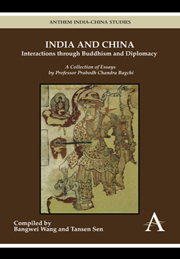 India and China: Interactions through Buddhism and Diplomacy
India and China: Interactions through Buddhism and Diplomacy Book contents
- Frontmatter
- Contents
- Compilers' Note
- Introduction (English and Chinese)
- Part One
- 1 Ancient Chinese Names of India
- 2 The Beginnings of Buddhism in China
- 3 Indian Influence on Chinese Thought
- 4 A Note on the Avadānaśataka and its Chinese Translation
- 5 Bodhisattva-śīla of Śubhākarasiṁha
- 6 A Fragment of the Kāśyapa Saṁhitā in Chinese
- 7 The Chinese Mysticism
- 8 Some Early Buddhist Missionaries of Persia in China
- 9 Some Letters of Hiuan-Tsang and his Indian Friends
- 10 New Lights on the Chinese Inscriptions of Bodhgayā
- 11 A Buddhist Monk of Nālandā amongst the Western Turks
- 12 Political Relations between Bengal and China in the Pathan Period
- 13 Chinese Coins from Tanjore
- 14 Report on a New Hoard of Chinese Coins
- 15 Ki-pin and Kashmir
- 16 Sino-Indian Relations – The Period of the United Empires (618–1100 A.D.)
- Part Two Short Articles
- Part Three Articles in Bengali
- Appendix
- Index
16 - Sino-Indian Relations – The Period of the United Empires (618–1100 A.D.)
from Part One
Published online by Cambridge University Press: 05 March 2012
- Frontmatter
- Contents
- Compilers' Note
- Introduction (English and Chinese)
- Part One
- 1 Ancient Chinese Names of India
- 2 The Beginnings of Buddhism in China
- 3 Indian Influence on Chinese Thought
- 4 A Note on the Avadānaśataka and its Chinese Translation
- 5 Bodhisattva-śīla of Śubhākarasiṁha
- 6 A Fragment of the Kāśyapa Saṁhitā in Chinese
- 7 The Chinese Mysticism
- 8 Some Early Buddhist Missionaries of Persia in China
- 9 Some Letters of Hiuan-Tsang and his Indian Friends
- 10 New Lights on the Chinese Inscriptions of Bodhgayā
- 11 A Buddhist Monk of Nālandā amongst the Western Turks
- 12 Political Relations between Bengal and China in the Pathan Period
- 13 Chinese Coins from Tanjore
- 14 Report on a New Hoard of Chinese Coins
- 15 Ki-pin and Kashmir
- 16 Sino-Indian Relations – The Period of the United Empires (618–1100 A.D.)
- Part Two Short Articles
- Part Three Articles in Bengali
- Appendix
- Index
Summary
The accession of the T'ang dynasty in 618 A.D. marks a new era in the history of China. It may be compared in glory and majesty only with the period of the great Han rulers. It is characterised by progress in all aspects of Chinese life, political, intellectual, religious and artistic. So far as Buddhism is concerned it was a period of assimilation and new creation of the Chinese genius. The Chinese, with the restoration of their distinctive political and social life and the revival of their literary traditions began to see what use they could make of this foreign religion in building up their national life which had been so much disturbed since the fall of the Hans. This led to the creation of a Buddhist civilisation in China which was much more than a mere copy of the Indian Buddhism.
The founder of the T'ang dynasty, Li-yuan who belonged to a nobility of ancient descent, took advantage of the weakness of the Sui rulers and with the help of his able son Li She-min seized the throne in 617 A.D. Ch'ang-ngan, the capital of the Sui, was occupied and Li-yuan was declared Emperor in 618. Li-yuan is better known in history under his posthumous name, Kao-tsu. The dynasty founded by him continued to reign till 907 A.D.
Kao-tsu was succeeded in 627 A.D. by his son Li She-min who is commonly known in history as T'ai-tsong. T'ai-tsong reigned till 649 A.D.
- Type
- Chapter
- Information
- India and China: Interactions through Buddhism and DiplomacyA Collection of Essays by Professor Prabodh Chandra Bagchi, pp. 155 - 176Publisher: Anthem PressPrint publication year: 2011


